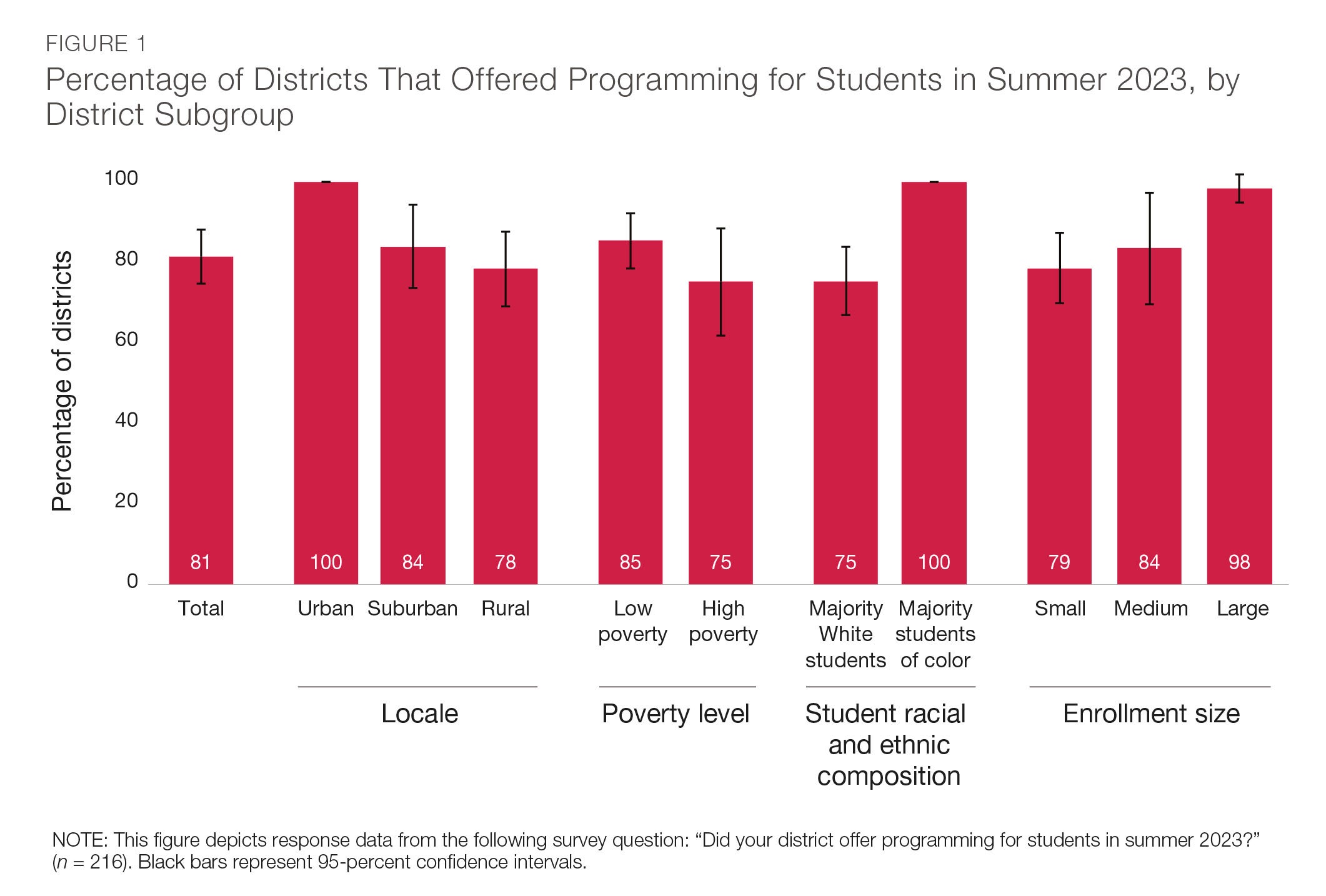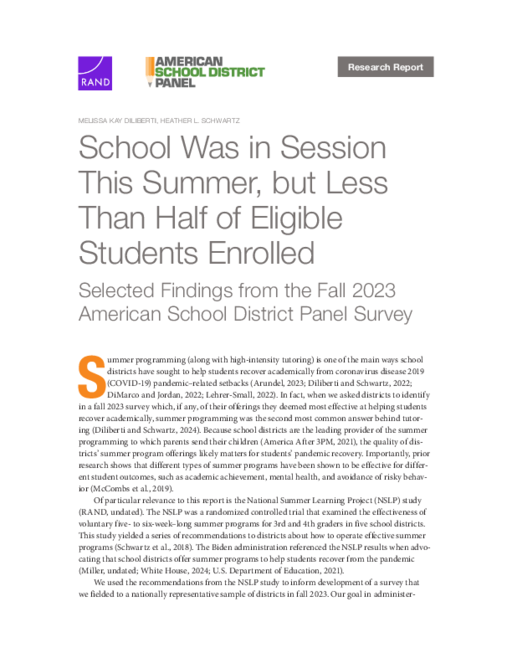Breadcrumb
- Wallace
- Reports
- School Was In This Summer, But L...
School Was in This Summer, but Less Than Half of Eligible Students Enrolled
Selected Findings from the Fall 2023 American School District Panel Survey

Overview
More
Less
- Author(s)
- Melissa Kay Diliberti and Heather L. Schwartz
- Publisher(s)
- RAND Corporation
- DOI Link
- https://doi.org/10.7249/RRA956-22
Summary
How we did this
Research by RAND represents data from a fall 2023 survey administered to a nationally representative sample of 231 school districts.
Summer learning programming is one of the most effective strategies school districts have used to help students recover from the pandemic—second only to tutoring.
Most children access summer programs through school districts, so the quality of these programs likely matters for students’ recovery. But how do districts approach their summer learning programs? And how many students who are eligible actually enroll?
To help answer these questions, The RAND Corporation conducted a survey in the fall of 2023 via the American School District Panel, a nationally representative sample of school districts across the country. RAND received responses from more than 200 school districts that varied by characteristics such as racial and ethnic composition, enrollment size, and locale.
The study found that 81 percent of districts surveyed operated programs in summer 2023. That’s the good news. On the flipside, only half of students eligible to attend the programs enrolled.
The report suggests implications and areas for improvement for districts that might want to double down on evidence-based approaches that blend academics with enrichment to create strong programs. This could help programs appeal to more students, including those who could benefit most.

Virtually all districts’ largest summer programs in summer 2023 included academic instruction daily.
Key highlights from the study include:
- Prevalence of summer programming: All or almost all urban districts, large districts, and districts serving mostly students of color offered at least one program during summer 2023. Sixty-three percent of districts nationally offered two or more programs in summer 2023.
- Profiles of districts’ largest summer programs in summer 2023: Virtually all districts’ largest summer programs included academic instruction, designed to address unfinished learning (e.g., tutoring, credit recovery). Almost all districts (98 percent) hired teachers from the district to deliver academic instruction.
- Eligibility restrictions: When restricting eligibility for summer programs, districts typically targeted students performing below grade level or needing to recover course credits. About half of districts (53 percent) indicated that their largest elementary summer program had no eligibility restrictions, and 49 percent of districts said similarly about their largest secondary summer program.
- Enrollment varied by eligibility restrictions and grade level: At both the elementary and secondary levels, enrollment rates were higher, on average, among districts that operated programs with eligibility restrictions than among districts that operated open enrollment programs.
- Looking ahead to 2024: Virtually all districts offered summer programming free of charge to families in summer 2023, but with the expiration of COVID-19 relief funds in September 2024, this might change considerably in the coming years.
The development of this survey was informed by recommendations stemming from a prior RAND study on summer learning commissioned by Wallace. The National Summer Learning Project was a randomized controlled trial that examined the effectiveness of voluntary five- to six-week–long summer programs for 3rd and 4th graders in five school districts. The study yielded several recommendations to districts about how to operate effective summer programs, such as hiring teachers with subject and grade expertise to deliver academic instruction and offering at least three hours of academic instruction per day.
Key Takeaways
- To reach more students who are struggling academically, districts’ summer programs will need to significantly increase enrollment. One way to do this is by communicating with parents, creating personalized recruitment materials or engaging teachers as trusted messengers.
- Summer programs—at least at the elementary level—need to be longer than four weeks to meet or exceed the number of academic instructional hours that prior research shows benefits elementary-grade students academically.
- Districts may want to consider starting to plan summer programs earlier during the academic year. That extra time can allow districts to lay the groundwork—particularly in communications, staffing, and planning—for higher-quality summer programming.
Visualizations

What We Don't Know
Students who originally enrolled in summer programs might never show, or students who do show might attend for fewer than all of the offered summer program days. Prior research found this to be the norm across the five districts’ elementary-grade summer programs before the pandemic. But is attendance in summer programs even lower now?

